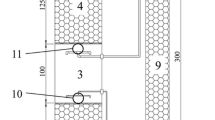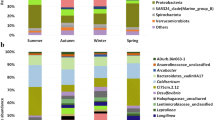Abstract
The structures of microbial communities in lab-scale upflow anaerobic sludge blanket (UASB) reactors for treating municipal wastewater with different ratios of CODsoluble/ CODtotal were studied using denaturing gradient gel electrophoresis (DGGE) of 16S rRNA genes. The microbial structure of the inoculum sludge obtained from a full-scale UASB reactor of treating potato processing wastewater was compared with the structures of sludges collected from three lab-scale UASB reactors after eight months feeding with raw municipal wastewater, with CEPS (chemically enhanced primary sedimentation) pretreated municipal wastewater, and with a synthetic municipal sewage, respectively. Computer-aided numerical analysis of the DGGE fingerprints showed that the bacterial community underwent major changes. The sludges for treating raw and CEPS pretreated wastewater had very similar bacterial and archaeal communities (82% and 96% similarity) but were different from that for treating the synthetic sewage. Hence, despite similar % COD in the particulate form in the synthetic and the real wastewater, the two wastewaters were selected for different microbial communities. Prominent DGGE bands of Bacteria and Archaea were purified and sequenced. The 16S rRNA gene sequences of the dominant archaeal bands found in the inoculum, and UASB sludge fed with raw sewage, CEPS pretreated wastewater, and synthetic sewage were closely associated withMethanosaeta concilii. In the UASB sludge fed with synthetic sewage, another dominant band associated with an uncultured archaeon 39-2 was found together withM. concilii.
Similar content being viewed by others
References
Hulshoff, P., Euler, H., Eitner, A. et al., GTZ sectoral project, promotion of anaerobic technology for the treatment of municipal and industrial sewagw and wastes, Proc. 8th Int. Conf. Anaerobic digestion, 1997, Japan, 285–292.
Van Haandel, A. C., Lettinga, G., Anaerobic sewage treatment— A practical guide for regions with a hot climate, Chichester: John Wiley and Sons Ltd., 1994, 226.
Van Lier, J. B., Tilche, A., Ahring, B. K. et al., New perspectives in anaerobic digestion, Water Sci. Tech., 2001, 43: 1.
Mergaert, K., Vanderhaegen, B., Verstraete, W., Applicability and trends of anaerobic pre-treatment of municipal wastewater, Water Res., 1992, 26: 1025.
Uemura, S., Harada, H., Treatment of sewage by a UASB reactor under moderate to low temperature conditions, Bioresource Technology, 2000, 73(3): 275.
Van der Last, A. R. M., Lettinga, G., Anaerobic treatment of domastic sewage under moderate climate (Dutch) condition using upflow reactors at increased superficial velocities, Water Sci. Tech., 1992, 25 (7): 167.
Kalogo, Y., Verstraete, W., Development of anaerobic sludge bed (ASB) reactor technologies for domestic wastewater treatment: motives and perspectives, World J. Microbiol. Biotech., 1999, 15: 523.
Kalogo, Y., Verstraete, W., Technical feasibility of the treatment of domestic wastewater by a CEPS-UASB system, Environ. Tech., 2000, 21: 55.
Aiyuk, S., Verstraete, W., Sedimentological evolution in a UASB treating synthes, a new representative synthetic sewage, at low loding rates, Bioresource Tech., 2003, 93 (3): 269.
Alphennaar, P. A., Groeneveld, N., Van Aelst, A. C., Scanning electron microscopical method for internal structure analysis of anaerobic granular sludge, Micron., 1994, 25: 129.
Fang, H. H. P., Chui, H. K., Chen, T., Performance and granule characteristics of UASB process treating wastewater with hydrolyzed protins, Water Sci. Tech., 1994b, 30: 55.
Fang, H. H. P., Chui, H. K., Li, Y. Y., Microbial structure and activity of UASB granules treating different wastewater, Water Sci. Tech., 1994a, 30: 87.
Thaveesri, J., Liessens, B., Verstraete, W., Granular sludge growth under different reactor liquit surface tensions in lab-scale upflow anaerobic sludge blanket reactors treating wastewater from suger-beet procrssing, Appl. Environ. Microbiol., 1995c, 43: 1122.
Thaveesri, J., Daffonchio, D., Liessens, B. et al., Granulation and sludge bed stability in upflow anaerobic sludge bed reactors in relation to surface thermodynamics, Appl. Environ. Microbiol., 1995a, 61: 3681.
Thaveesri, J., Gernaey, K., Kaonga, B. et al., Organic and ammonium nitrogen and oxygen in relation to granular sludge growth in lab-scale UASB reactors, Water Sci. Tech., 1995b, 30 (12): 43.
Souza, J. T., Foresti, E., Domestic sewage treatment in an upflow anaerobic sludge blanket-sequencing batch reactor system, Water Sci. Tech., 1996, 33 (3): 73.
Kato, M. T., Field, J. A., Lettinga, G., The anaerobic treatment of low strength wastewaters in UASB and EGSB reactor, Water Sci. Tech., 1997, 36 (6–7): 375.
Polpraset, C., Gnanadipathy, A., Treament of a domestic wastewater with UASB reactors, Water Sci. Tech., 1993, 27 (1): 195.
Ghyoot, W., Verstraete, W., Reduced sludge production in a two-stage membrane-assisted bioreactor, Water Research, 2002, 34: 205.
Curtis, T. P., Craine, N. G., The comparison of the diversity of activated sludge plants, Water Sci. Tech., 1998, 37: 71.
Eichner, C. A., Erb, R. W., Timmis, K. N. et al., Thermal gradient gel electrophoresis analysis of bioprotection from pollutant shocks in the activated sludge microbial community, Appl. Environ. Microbiol., 1999, 65: 102.
Muyzer, G., Smalla, K., Application of denaturing gradient gel electrophoresis (DGGE) and temperature gradient gel electrophoresis (TGGE) in microbial ecology, Antonie Van Leeuwenhoek Int. J. Gen. Mol. Microbiol., 1998, 73: 127.
Van Elsas, J. D., Duarte, G. F., Rosado, A. S. et al., Microbiological and molecular biological methods for monitoring microbial inoculants and their effects in the soil environment, J. Microbiol. Methods, 1998, 32: 133.
Sekiguchi, Y., Kamagata, Y., Syutsubo, K. et al., Phylogenetic diversity of mesophilic and thermophilic granular sludges determined by 16S rRNA gene analysis, Microbiology, 1998, 144: 2655.
Chan, O. C., Liu, W. T., Fang, H. H. P., Study of microbial community of brewery-treating granular sludge by denaturing gradient gel eletrophoresis of 16S rRNA gene, Water Sci. Tech., 2001, 43: 77.
Aiyuk, S., Amoako, J., Verstraete, W., Concurrent removal of carbon and nutrients from raw domestic sewage using the list integrated concept, Water Research, 2004 (in press).
Boon, N., Goris, J., De Vos, P. et al., Bioaugmentation of activated sludge by an indigenous 3-chloroaniline degrading Comamonas testosteroni strain, 12gfp., Appl. Environ. Microbiol., 2000, 66: 2906.
Reysenbach, A. L., Giver, L. J., Wickham, G. S. et al., Differential amplification of rRNA genes by polymerase chain reaction, Appl. Environ. Microbiol., 1992, 58: 3417.
Muyzer, G., Dewaal, E. C., Uitterlinden, A. G., Profiling of complex microbial populations by denaturing gradient gel electrophoresis analysis of Polymerase chain reaction-amplified genes coding for 16S rRNA, Appl. Environ. Microbiol., 1993, 59: 695.
Liu, W. T., Chan, O. C., Fang, H. H. P., Characterization of microbial community in granular sludge treating brewery wastewater, (Unpublished).
Ahn, I.S., Kwon, J. C., Dependence of wastewater treatment efficiencies on treatment system and its bacterial community composition, to be published.
Schlotelburg, C., Von Wintzingerode, F., Hauck, R. et al., Bacteria of an anaerobic 1,2-dichloropropane-dechlorinating mixed culture are phylogenetically related to those of other anaerobic dechlorinating consortia, Int. J. Syst. Evol. Microbiolloteburg, 2000, 1505.
Gu, A. Z., Hedlund, B. P., Strand, S. E. et al., Characterization and comparison of community structure of a TCE—reducing and a cis-DCE-reducing culture using molecular methods to be published.
Teske, A., Hinrichs, K. U., Edgcomb, V. et al., Microbial diversity of hydrothermal sediments in the Guaymas Basin: evidence for anaerobic methanotrophic communities, Appl. Environ. Microbiol., 2002, 68 (4): 1994.
Dennis, P. C., Sleep, B. E., Fulthorpe, R. R. et al., Phylogenetic characterization of an anaerobic bacterial consortium capable of degrading saturation concentrations of tetrachloroethene, to be published.
LaPara, T. M., Nakatsu, C. H., Pantea, L. et al., Phylogenetic analysis of bacterial communities in mesophilic and thermophilic bioreactors treating pharmaceutical wastewater, Appl. Environ. Microbiol., 2000, 66(9): 3951.
Oude Elferink, S. J., Maas, R. N., Harmsen, H. J. et al., Desulforhabdus amnigenus gen. nov. sp. nov, a sulfate reducer isolated from anaerobic granular sludge, Arch. Microbiol., 1995, 164(2): 119.
Bleui, C., Molecular analysis of microbial communities in sediments of water reservoirs (2002), to be published.
Holmes, A. J., Tujula, N. A., Holley, M. et al., Phylogenetic structure of unusual aquatic microbial formations in Nullarbor caves, Australia, Environ. Microbiol., 2001, 3 (4): 256.
Grosskopf, R., Janssen, P. H., Liesack, W., Diversity and structure of the methanogenic community in anoxic rice paddy soil microcosms as examined by cultivation and direct 16S rRNA gene sequence retrieval, Appl. Environ. Microbiol., 1998, 64: 960.
Purdy, K. J., Munson, M. A., Nedwell, D. B. et al., Comparison of the molecular diversity of the methanogenic community at the brackish and marine ends of a UK estuary, FEMS Microbiol. Ecol., 2002, 39: 17.
Pender, S., Toomey, M., Carton, M. W. et al., Effect of sulphate on methanogenic population dynamics in anaerobic fs during long-term operation under mesophilic and thermophilic conditions, 2001 to be published.
Williams, D., Haas, E. S., Brown, J. W., Surprising archaeal diversity in a municipal wastewater sludge, to be published.
Cilia, V., Lafay, B., Christen, R., Sequence heterogeneities among 16S ribosomal RNA sequences, and their effect on phylogenetic analyses at the species level, Mol. Biol. Evol., 1996, 13: 451.
Vallaeys, T., Topp, E., Muyzer, G. et al., Evaluation of denaturing gradient gel electrophoresis in the detection of 16S rDNA sequence variation in rhizobia and methanotrophs, FEMS Microbiol. Ecol., 1997, 24: 279.
Maaloe, O., Kjeldgaard, N. O., Control of Macromolecular Synthesis. Benjamin, New York, 1996.
Kemp, P. F., Lee, S., LaRoche, J., Estimating the growth rate of slowly growing marine bacteria from RNA content. Appl. Environ. Microbiol., 1993, 59: 2594.
Godon, J. J., Zumstein, E., Dabert, P. et al., Molecular microbial diversity of an anaerobic digester as determined by small-subunit rDNA sequence analysis, Appl. Environ. Microbiol., 1997, 63: 2802.
Rocheleau, S., Greer, C. W., Lawrence, J. R. et al., Differentiation ofMethanosaeta concilii andMethanosarcina barkeri in anaerobic mesophilic granular sludge by fluorescentin situ hybridization and confocal scanning laser microscopy, Appl. Environ. Microbiol., 1999, 65: 2222.
Marchesi, J. R., Sato, T., Weightman, A. J. et al., Design and evaluation of useful bacterium-specific PCR primers that amplify genes coding for bacterial 16S rRNA, Appl. Environ. Microbiol., 1998, 64: 795.
Heuer, H., Krsek, M., Baker, P. et al., Analysis of actinomycete communities by specific amplification of genes encoding 16S rRNA and gel-electrophoretic separation in denaturing gradients, Appl. Environ. Microbiol., 1997, 63: 3233.
Lane, D. J., 16S/23S rRNA sequencing, in Nucleic acid Techniques in Bacterial Systematics, New York: John Wiley & Sons Ltd., 1991, 115–175.
Overas, L., Forney, L., Daae, F. L. et al., Distribution of bacterioplankton in meromictic lake sælenvannet, as determined by denaturing gradient gel electrophoresis of PCR-Amplified gene fragments coding for 16S rRNA, Appl. Environ. Microbiol., 2001, 63: 3367.
Author information
Authors and Affiliations
Corresponding author
Rights and permissions
About this article
Cite this article
Zhang, Y., Aiyuk, S., Xu, H. et al. Study of microbial community structures in UASB sludge treating municipal wastewater by denaturing gradient gel electrophoresis of 16S rDNA. Sci. China Ser. C.-Life Sci. 48 (Suppl 1), 128–135 (2005). https://doi.org/10.1007/BF02889810
Received:
Issue Date:
DOI: https://doi.org/10.1007/BF02889810




